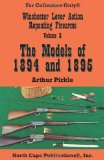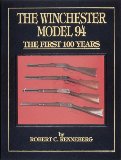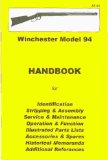Articles on the Winchester Model 94
The woods loafer’s gun: Winchester’s darling .25-35 WCF is back
Introduced in the Model 94 Winchester in 1895 together with the .30-30 and discontinued in 1952, Winchester’s mild-mannered .25-35 is back in the Model 94 line. It’s about time, for it’s a pleasant little cartridge, easy to shoot, easy on the shoulder, easy to reload and, on the average, the most accurate cartridge ever chambered in a Model 64 or Model 94 Winchester.
Gone but not forgotten: Winchester’s 9422 lever action
I was shocked and sorry to learn 9422 production is ending. The 2005 catalog lists a series of tribute models in various degrees of engraving and price range, closing out a 33-year run of one of the finest .22s ever made.
Winchester Model 94 Manuals
Model 94 Top Tang Safety
Model 9410 Top Tang Safety
Model 9417 & 9422
Books on the Winchester Model 94

Winchester Lever Action Repeating Firearms, Vol. 3, The Models of 1894 and 1895
The long-awaited third volume of Arthur Pirkle’s massive study of the Winchester lever action repeating firearms is now available. It provides all the part-by-part details on the most popular collectible and hunting models of the Winchester series found in previous volumes.
By the early 1890s, smokeless power and high strength alloy steels were close to being perfected. Smokeless powder was revolutionizing the firearms industry. The more powerful propellants were making it possible to accelerate small caliber bullets to double and triple the speeds of black powder. This allowed smaller cartridges and in turn more compact rifles. The high strength steels provided stronger barrel capable of resisting the erosive effects of the smokeless powders burning at far high temperatures than those incurred with black powder.
The Model 1894 was John Browning’s modernized version of his ground-breaking Model 1886 design. The internal locking lugs were not only stronger but were faster to actuate, making it possible to cock the rifle for the next shot more quickly than with previous models. New cartridges like the .30-30 and the .32-30 were far more powerful than even the big game cartridges developed for the model 1886 but in a package hardly larger and heavier than the M1892. Almost immediately, the Model 1894 rifle and carbine became “America’s deer rifle,” a position it still holds today, more than century later.
The Model 1895 was another John Browning design and one developed to handle the powerful new smokeless cartridges like the .30-40 Krag and the .30-06 developed for the U.S. military. The M1895 was a radical departure from previous Winchester lever actions. Its longer receiver was easily capable of handling the long and powerful .30-06 cartridge. The rifle quickly established itself as the premier American big game rifle. Teddy Roosevelt was an early and loyal supporter and hunted throughout the world with the M1895.
Because the Models 1894 and 1895 were developed later and the M1894 remains in production today collector interest in both rifles began later and developed more slowly than with previous Winchester lever actions. Today, that interest is a full peak. Both rifles are plentiful on the collector’s market and the prices are far lower than for earlier models. For the price of one M1886 carbine, a collector can assemble a representative collection of M1894s; for the price of two M1866 carbines, a representative collection of M1895s.
As with previous volumes in this series, all parts are described in sequence by serial number range. All markings, dimensions and finishes plus any changes to that part are fully explained and the part illustrated with clear and concise line drawings.
Appendixes contain a history of both rifle’s development plus descriptions of the Musket versions of both, serial number charts that have been revised and corrected and new exploded views.

The Winchester Model 94: The First 100 Years
n production for over one hundred years, and with over seven and one half million of these rifles produced so far, there isn’t any question that the most popular deer rifle in America is the Winchester Model 1894, and that it has held that favorite spot for quite some time.
The author begins with a concise, accurate history of this timeless lever action that starts with it’s designer John Moses Browning and carries right up through the post 1964 models, the commemoratives and the latest angle eject 94’s. Every aspect of the 1894 is covered; engineering changes, alterations, finishes, calibers and wood, often in great detail. The components, and variations thereof, are graphically presented with very clear close-up black and white photography. Collectors love it when information is offered to them in such a way that it quickly answers all their questions. So often I have been asked “Can you show me what to look for with such and such a detail, so I will know what I am buying?”. This is that book for the Winchester 1894, it answers questions quickly and it shows you what and where.
Fanciers of the Winchester Model 1894 will be absolutely delighted with what is in this book for it truly gives you “everything you ever wanted to know about the 1894 Winchester”, as well as covering a lot of questions you probably wouldn’t have thought to ask. I also enjoyed seeing the excerpts from early 20th century Winchester salesman’s catalogs, where for instance, a standard 38-55 caliber carbine could be had for the hefty sum of $17.50!
This reviewer was very impressed with the large amount of well presented information and the attention that is given to accurate photographic illustration. The book was a joy to read and I would highly recommend it for the library of anyone who collects or who simply enjoys Winchester’s wonderful Model 1894.

Winchester Model 94 Assembly, Disassembly Manual
Ideal workshop reference for stripping and assembly with exploded parts drawings, specifications, service accessories, historical information and recommended reading references. And ideal workbook for shooters and collectors alike. 36 pp, over 60 photos and line drawings. Triple saddle-stitched binding with durable plastic laminated cover makes this an ideal workshop guide.

I own a 94AE circa 1982 in near new condition. Would like to know more about it’s value. Other than that I love shootin it and it’s VERY accurate! Beautiful little rifle for the $100 I bought it for.
Comments are closed.